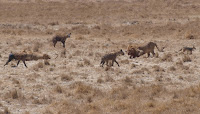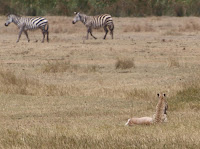The crater floor is the collapsed cone of an extinct volcano. Today it provides a diverse habitat to many of Africa's most popular animals including lions, cheetahs, elephants, wildebeests, zebras, hippos and rhinos. I was personally amazed at the arid dryness throughout the area that allowed us to actually see evaporation off the surface of the alkaline lake in the distance. And yet, not but a few miles away, elephants were observed drinking the cool fresh water provided by springs peculating up through the earth's surface.
As for those two experiences, the first was that of a pair of lions, presumably a male and his mate
 sharing a mid morning kill. By the time we arrived on the site, there were some 20 safari vehicles lining the roadside observing out in the distance as the two fed. What was more interesting was the flurry of activity surrounding them, as a pack of some 20-25 hyenas were attempting to take away some morsel to eat. Also, there were a handful of jackals what we were told are allowed to co-dine with lions as they pose no threat to them. Hyenas however, are another story. The lions defended and chased away lone hyenas as they attempted to steal away something for themselves.
sharing a mid morning kill. By the time we arrived on the site, there were some 20 safari vehicles lining the roadside observing out in the distance as the two fed. What was more interesting was the flurry of activity surrounding them, as a pack of some 20-25 hyenas were attempting to take away some morsel to eat. Also, there were a handful of jackals what we were told are allowed to co-dine with lions as they pose no threat to them. Hyenas however, are another story. The lions defended and chased away lone hyenas as they attempted to steal away something for themselves.One was successful in getting what appeared to be a leg or some part of one. As the dog-like animal scampered off with its steal, others were chasing behind trying to catch and take away the meal.
 Eventually, another did catch and take the food away. Curiously, that was the end of the chase as if pack leader, alpha dog was in possession of the food. It went off in an opposite direction to feast on the spoils of victory.
Eventually, another did catch and take the food away. Curiously, that was the end of the chase as if pack leader, alpha dog was in possession of the food. It went off in an opposite direction to feast on the spoils of victory.Later in the day after lunch we stumbled upon a cheetah resting in the tall straw like grass. Not seemingly aware of anything around,
 it stood up and stretched. As it sauntered right to left across the crater floor, its posture changed. It went from taking a stroll to what was clearly a stalking position. Walking, crouching, stopping to lay in the grass . . . the cheetah had it sights on a gazelle some 200 yards off in the distance.
it stood up and stretched. As it sauntered right to left across the crater floor, its posture changed. It went from taking a stroll to what was clearly a stalking position. Walking, crouching, stopping to lay in the grass . . . the cheetah had it sights on a gazelle some 200 yards off in the distance.We continued to watch, as our driver repositioned our vehicle moving quite a distance
 backwards as the cheetah continued to make its way towards a small group of gazelles. We stopped as it stopped. We watched as it watched. I found myself holding my breath as I saw the cheetah go totally flat in the grass. Just 32 seconds later, the cheetah was on the gazelle taking it down to the ground.
backwards as the cheetah continued to make its way towards a small group of gazelles. We stopped as it stopped. We watched as it watched. I found myself holding my breath as I saw the cheetah go totally flat in the grass. Just 32 seconds later, the cheetah was on the gazelle taking it down to the ground.
I've read that only about 1:100 safari visitors are witness to a kill. It was an amazing thing to experience first hand. The beauty of the lean cheetah making way across to what was seemingly a totally unsuspecting gazelle, is almost beyond words. The tragedy of the death of the gazelle while sad, is all part of the food chain in the wild. What is more tragic, death by starvation or at the jaws of another?
No comments:
Post a Comment